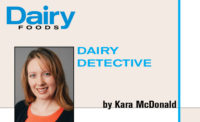The time is right for drinkable yogurts to take off in the United States

Some cultured dairy beverages can be very effective at quenching thirst. Such beverages can also be described as nutrient-packed foods that can:
- Contribute to satiety
- Improve overall health (via probiotics)
- Serve as a convenient or meal replacement
- Provide a tasty and enjoyable eating experience
So are cultured dairy beverages tasty functional foods, convenient drinks, probiotic carrier systems, dieters’ dream elixirs or all of the above?
Some would say: “Let’s be everything to everybody,” while others might say: “The maturity of this market requires segmentation strategies which necessitate that we communicate why our product is distinctly different from the more generic brands.”
Demystifying the beverage
So what is a “cultured dairy beverage?” The Code of Federal Regulations Title 21 part 131.112 provides a definition for a “cultured milk” and gives some flexibility to use some “optional ingredients,” a range of processing and ingredient technologies, and allowances to use some “traditional names.”
Despite the fact that yogurt clearly is a fermented/cultured milk, there is a separate regulation under Part 131.2 for this product. Additionally we have defined a “dairy beverage” as “milk and dairy food beverages that do not conform to Title 21 of the Code of Federal Regulations because they contain safe and suitable ingredients or combinations of ingredients not specified in those standards . . .”
In my book there is no clear definition for a cultured dairy beverage. The term is really used primarily to describe a product category with a collection of fermented milk/dairy products. Now that I have added my contribution to the confusion of dairy product regulations and nomenclature, let’s move on.
Learning from the world around us
Southwest Asian, Mediterranean and Middle Eastern cultured milks are characterized as low solids, often diluted with water and containing added salts. Turkish ayran or Iranian doogh are just two examples of just such beverages with wide popularity in their respective countries.
The low solids help insure that the viscosity is pleasingly low and go along with a relatively higher water content, both of which are consistent with a refreshing beverage that provides hydration. The added salts may help to restore electrolytes and give a characteristic salty flavor and improve keeping quality of the final product.
Dill, mint, lime juice, olive oil, crushed garlic, paprika, black pepper and other condiments are used as flavoring agents. Newer versions of these cultured dairy beverages are sweetened and have fruit flavors. These products are consumed as beverages, side dishes, sauces and dips. This versatility undoubtedly adds to their strong popularity in these parts of the world.
Today, advances in culture technology and ingredient technology allow for the consistent high-quality production of cultured dairy beverages with low viscosity, good shelf life and little to no phase separation. Post-fermentation homogenization of fermented milks in the presence of desired stabilizing systems may also help to insure low viscosity with good product stability.
Kefir is a fermented milk beverage originally from the Caucasus mountain region of Russia. It is particularly refreshing as a result of both lactic acid bacterial and yeast fermentation. The yeast fermentation produces a natural carbonation/effervescence to kefir to enhance its appeal as a beverage.
While many kefir products produced industrially do not commonly undergo yeast fermentation (hence may not be carbonated), I would prefer some dairy beverages “with gas,” just like my bottled water. Acidity and carbonation go together nicely — just ask Coke or Pepsi. The added effervescence and acidity provides a tactile sensation that adds value and enhances the “refreshment factor” for me.
While carbonated dairy beverages have been launched and taken off the market more times than I want to remember, I still think there is a lot of unfilled demand for introduction of the right product with the right product attributes, at the right time, at the right price point, in the right package, with the right name and marketed to the right market segment.
Small (1.5- to 3-ounces) cultured dairy beverage shots are increasing in popularity. These products have been a mainstay in Korea and Japan for some time now. Such shots usually contain concentrated amounts of specific probiotic bacteria (approximately 10 billion good-for-you probiotic organisms per container) and prebiotic functional ingredients.
While undoubtedly it took years to convince consumers to get a daily dose of a cultured dairy beverage, it certainly has worked and seems to be crossing the Pacific to the U.S. marketplace. One-a-Day Cultured Dairy Beverage Shots may be near its tipping point.
What should you do?
There are very few easy answers in the dairy business, but stagnation associated with no action is not the solution. There are some real business opportunities out there. Cultured dairy beverage companies are in the enviable position of having a strong foundation associated with a food that tastes good and is good for you. Figuring out how to leverage this into business opportunities is there for your taking.
Looking for a reprint of this article?
From high-res PDFs to custom plaques, order your copy today!









